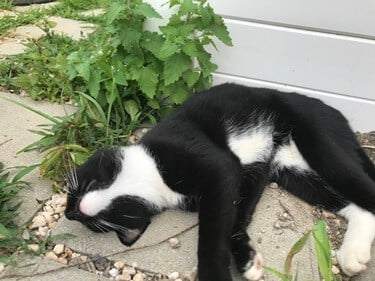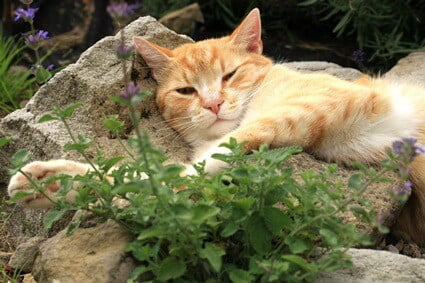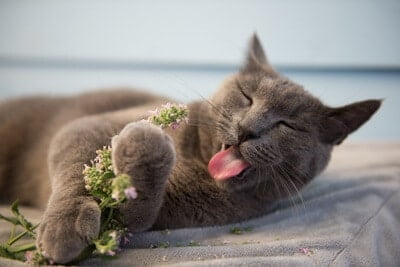Felines react to catnip with a burst of energy and what appears to be happiness. It can give your cat the zoomies and make it wild during playtime. This can be a great way to brighten up your cat’s day and encourage certain behaviors. The question comes, of course, of how to give catnip to cats.
To use catnip for cats, crush the herb’s leaves into a fine powder. This can be sprinkled on toys, food, beds, or scratching posts. Catnip contains nepetalactone, an essential oil that stimulates feline pleasure receptors. Catnip comes in spray form, but it contains less nepetalactone.
Too much catnip won’t kill your cat, and the worst that will happen is an upset stomach. This may result in vomiting and diarrhea if the feline consumes too much. The good news is that catnip is easy to ration with toys, and most cats will stop interacting with the herb once they’ve had enough.
What Is Catnip?
Originating from Europe and Asian countries, catnip is a minty, lemon-tinted herb. It belongs to the scientific classification of nepeta cataria. Cats derive such a pleasant feeling and burst of energy from catnip that the plant is named after them.
Catnip is a minimally invasive, perennial herb that has an unusual effect on cats. It makes some cats hyperactive, causing them to get the zoomies and run about the house.
However, some cats become mellow, sluggish, and appear in the feline equivalent of ‘high’ after consuming catnip. It depends on the cat, its age, and the amount of catnip you provide.
Why Do Cats Love Catnip?
Catnip’s allure lies in a volatile oil found in its stems, leaves, and even seeds called nepetalactone. According to Science Advances, this active ingredient alters the behavior of domestic and wild cats.
About 70-80% of all cats exhibit changed behavior after exposure to catnip. However, it’s important to note that this response is deemed hereditary.
Some cats might not react to the catnip at all, and that’s fine. It doesn’t mean your cat is unwell, nor is it a sign that there’s something wrong with its response system.
Catnip affects each cat differently, meaning that your cat could respond in the usual way, with excess energy, or in peculiar ways.
Some cats rub their heads and bodies onto the herb, while others enjoy rolling around it. You might even notice your cat salivating and wanting a bite of the plant.
Benefits of Catnip for Your Cats
The most common benefit of catnip is that it helps cats relax. They often dive into playtime and run around the home with this good feeling. Some cats relax and take a nap, feeling more affectionate than normal. In any case, it makes them exceptionally happy. However, the advantages don’t end there.
There are health and training benefits from giving catnip to cats, including:
- Encouraging play to keep your cat healthy and fit.
- Reducing stress levels in anxious cats.
- Helping calm your cat down during car trips to the vet.
- Eliminating restlessness in nervousness cats.
- Bribing your cat as a treat to improve training efforts
How To Use a Catnip Plant
When deciding how to use catnip, you should first choose the form it takes.
Catnip is available in numerous varieties, including:
- Fresh catnip plants
- Dried catnip
- Catnip sprays
- Catnip toys
Since catnip is a rather easy plant to grow, most vets recommend offering it fresh to cats. You can grow the catnip plant indoors in a container or even leave it outdoors in a plant bed. This depends on your home and the amount of catnip you’d like to grow.
When growing indoors, make sure the container is large enough not to be tipped over if your cat gets access to it. Moreover, you should keep in mind that the plant can grow quite large and prefers full sun.

How To Prepare Catnip for Cats
If you’ve decided to grow your own catnip, you can offer it to your cats fresh from the plant.
Here’s how to prepare fresh catnip for cats:
- Plant the catnip seeds early in spring, right after frost has cleared from the air.
- Offer the plant at least 6 hours of full sunlight.
- Harvest your catnip in late spring after it has bloomed well.
- Ensure your plant is at least 6 inches before harvesting.
- Offer some freshly clipped catnip stems to your cats.
- Store the rest of the harvested catnip in an airtight jar after drying it well for future use.
Can I Put Catnip in Cat’s Food?
Some owners are concerned that offering catnip directly, such as through food, will be too much for them. The good news is that it’s harmless and is even a recommended way to offer this herb.
You can safely sprinkle some catnip over their food. Since ingesting catnip is completely safe for your cats, putting some in their food won’t do any harm. Keep the quantity low as too much catnip can result in vomiting and digestion problems.
Is Catnip Tea Safe for Cats?
Cats aren’t thirst-driven, so it can be difficult to entice them into staying hydrated, especially if you don’t offer wet food. Catnip tea is a safe way to offer this herb to your cats, as well as encourage them to drink.
To make it, you need to do the following:
- Mix two teaspoons of dried catnip leaves into one cup of boiling water
- Stir it well
- Leave it to cool
- Offer your cat ½ a cup at a time
Recipes often call for adding honey into the tea, but this should be avoided. Although it’ll improve the flavor, you’re preparing the tea for your cat, not for yourself.
Cats shouldn’t be offered sweet foods, including natural sweeteners like honey, since they don’t have the digestive enzymes to break it down. Honey isn’t a natural part of a cat’s diet, so it can’t process it.
Moreover, cats are unlikely to experience the sweet flavor anyways.
Using a Catnip Spray
For an easier method of offering catnip to your cat, you can buy sprays at your local pet store. This is ideal if you lack the space, time, or interest in gardening but still want to offer it to your cat.
Catnip spray is a spray that contains the volatile oils that cats react so strongly to. This design doesn’t reduce the potency or quality of catnip. In fact, it can offer a stronger dose with less effort, working well as an occasional treat. Catnip sprays are mess-free and easy to use.
All you need to do is spray some catnip over your cat’s favorite toys, scratching posts, or even its bed. When the cat sniffs these areas, it’ll ingest the catnip.
This is a great way to encourage your cat to spend more time in certain areas and associate these spots with good memories. It can make cats that prefer scratching furniture switch to their designated posts and even keep your feline off the counters and snug in its bed.
Don’t be surprised if you find your cat rolling around and rubbing against wherever you spray the herb.
Should I Get Catnip Toys for My Cat?
To encourage exercise, the best way to offer catnip is through toys. There are hundreds of catnip toys available in pet stores and online.
They’re often hollow at their center and stuffed with dried catnip. There may be slots peppered around the sides of a plastic toy, or the toy may be fabric with pores in its threads. This allows your cat to immediately recognize the stimulating scent of the herb and react to it.
The best part is that your cat doesn’t get direct exposure to the catnip, eliminating any chances of overdosing on the herb. Instead, it’ll be encouraged to bat around the toy, scratching and biting it to gain access. This measures out the scent and small bits of the herb over time.
What Age Can Cats Have Catnip?
It’s best to give your feline catnip once it’s already an adult or to older juveniles.
Since catnip often makes cats more energetic, owners mistakenly assume that it can be offered to kittens, but this is unwise. Most kittens don’t react to catnip because they haven’t yet developed sensitivity to nepetalactone, which is the active compound in the catnip herb.
A better idea is to offer your cats catnip after turning 6 months old. Ages 6-8 months is when your cat will undergo full behavioral changes, including the ability to detect and react to catnip.

How Long Does Catnip Take to Kick In?
It doesn’t take much time for catnip to stimulate a feline’s senses. According to Behavioural Processes, you’ll notice numerous active and passive responses to the herb in a matter of seconds.
These responses include your cat sniffing, chewing, and licking the catnip. It might rub its body against the herb and drool on the floor. This is usually followed by hyperactivity or zoomies, with your cat running about at top speed.
Catnip effects usually wear off within 15-20 minutes for most cats. After this time, your cat will probably get a glazed-over look in its eyes and lay down, feeling exhausted.
The effects of catnip wear down slowly, so it’ll be another 2 hours before your cat reacts to catnip again. Offering it before this period has passed won’t do any good since the cat will have no response to it.
Experts recommend giving catnip to your cats no more than once a day. Despite being safe and non-toxic, overdosing on catnip can result in diarrhea and vomiting.
How Much Fresh Catnip Can You Offer A Cat?
Cats normally only consume safe amounts of catnip, so they’ll likely refuse more once it’s had enough. However, other cats can get carried away. To prevent this, give catnip in small doses.
It’s estimated that cats can smell catnip at an astounding ratio of 1:1 billion in the air. A cat’s nose is already 14 times more sensitive than a human being’s, and catnip further increases this sensitivity.
When offering it fresh, you can give your cat some of the herb every 2 weeks or so. Remember that fresh catnip is more potent than other forms.
Can Too Much Catnip Kill a Cat?
There’s no ingredient in catnip that will harm your cat, much less kill it.
Pet owners often worry that catnip is the feline equivalent of a harmful narcotic. So, it’s natural to associate the harmful effects of such strong medication with catnip too. In truth, this is unfounded.
Catnip is non-toxic and safe for cats to enjoy. The only reason experts recommend limiting your cat’s exposure to catnip is to ensure that it continues being a stimulant. Offering catnip every day will cause its effects to wear off, and eventually, your cat won’t react to the herb at all.
The only danger that comes with your cat consuming too much catnip is an upset stomach. You might notice your cat feeling sickly once the stimulating effects wear down.
None of these negative effects are serious or life-threatening. Your cat’s body will adjust to the catnip on its own, and your cat will be just fine after resting for a bit.
The best ways to offer it are fresh, dried, in toys, or as a spray. Regardless of your choice, your cat should enjoy the boost of energy and the extra fun it has during playtime.

